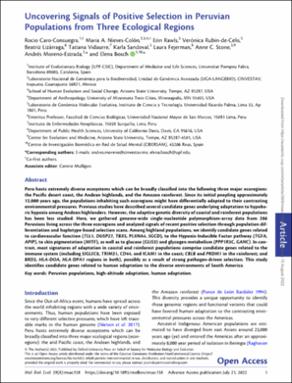Uncovering Signals of Positive Selection in Peruvian Populations from Three Ecological Regions
Fecha
2022-07-21Autor
Caro-Consuegra, Rocio
Nieves-Colón, Maria A.
Rawls, Erin
Rubin-de-Celis, Verónica
Lizárraga, Beatriz
Vidaurre, Tatiana
Sandoval, Karla
Fejerman, Laura
Stone, Anne C.
Moreno-Estrada, Andrés
Bosch, Elena
Metadatos
Mostrar el registro completo del ítemResumen
Peru hosts extremely diverse ecosystems which can be broadly classified into the following three major ecoregions: the Pacific desert coast, the Andean highlands, and the Amazon rainforest. Since its initial peopling approximately 12,000 years ago, the populations inhabiting such ecoregions might have differentially adapted to their contrasting environmental pressures. Previous studies have described several candidate genes underlying adaptation to hypobaric hypoxia among Andean highlanders. However, the adaptive genetic diversity of coastal and rainforest populations has been less studied. Here, we gathered genome-wide single-nucleotide polymorphism-array data from 286 Peruvians living across the three ecoregions and analyzed signals of recent positive selection through population differentiation and haplotype-based selection scans. Among highland populations, we identify candidate genes related to cardiovascular function (TLL1, DUSP27, TBX5, PLXNA4, SGCD), to the Hypoxia-Inducible Factor pathway (TGFA, APIP), to skin pigmentation (MITF), as well as to glucose (GLIS3) and glycogen metabolism (PPP1R3C, GANC). In contrast, most signatures of adaptation in coastal and rainforest populations comprise candidate genes related to the immune system (including SIGLEC8, TRIM21, CD44, and ICAM1 in the coast; CBLB and PRDM1 in the rainforest; and BRD2, HLA-DOA, HLA-DPA1 regions in both), possibly as a result of strong pathogen-driven selection. This study identifies candidate genes related to human adaptation to the diverse environments of South America.


